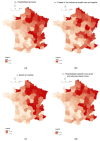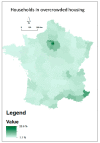Geographical Pattern of COVID-19-Related Outcomes over the Pandemic Period in France: A Nationwide Socio-Environmental Study
- PMID: 33668482
- PMCID: PMC7918139
- DOI: 10.3390/ijerph18041824
Geographical Pattern of COVID-19-Related Outcomes over the Pandemic Period in France: A Nationwide Socio-Environmental Study
Abstract
Background: Several studies have investigated the implication of air pollution and some social determinants on COVID-19-related outcomes, but none of them assessed the implication of spatial repartition of the socio-environmental determinants on geographic variations of COVID-19 related outcomes. Understanding spatial heterogeneity in relation to the socio-environmental determinant and COVID-19-related outcomes is central to target interventions toward a vulnerable population.
Objectives: To determine the spatial variability of COVID-19 related outcomes among the elderly in France at the department level. We also aimed to assess whether a geographic pattern of Covid-19 may be partially explained by spatial distribution of both long-term exposure to air pollution and deprived living conditions.
Methods: This study considered four health events related to COVID-19 infection over the period of 18 March and 02 December 2020: (i) hospitalization, (ii) cases in intensive health care in the hospital, (iii) death in the hospital, and (iv) hospitalized patients recovered and returned back home. We used the percentage of household living in an overcrowding housing to characterize the living conditions and long-term exposure to NO2 to analyse the implication of air pollution. Using a spatial scan statistic approach, a Poisson cluster analysis method based on a likelihood ratio test and Monte Carlo replications was applied to identify high-risk clusters of a COVID-19-related outcome.
Result: our results revealed that all the outcomes related to COVID-19 infection investigated were not randomly distributed in France with a statistically significant cluster of high risk located in Eastern France of the hospitalization, cases in the intensive health care at the hospital, death in the hospital, and recovered and returned back home compared to the rest of France (relative risk, RR = 1.28, p-value = 0.001, RR = 3.05, p = 0.001, RR = 2.94, p = 0.001, RR = 2.51, p = 0.001, respectively). After adjustments for socio-environmental determinants, the crude cluster shifts according to different scenarios suggested that both the overcrowding housing level and long-term exposure to largely NO2 explain the spatial distribution of COVID-19-related outcomes.
Conclusions: Our findings suggest that the geographic pattern of COVID-19-related outcomes is largely explained by socio-spatial distribution of long-term exposure to NO2. However, to better understand spatial variations of COVID-19-related outcomes, it would be necessary to investigate and adjust it for other determinants. Thus, the current sanitary crisis reminds us of how unequal we all are in facing this disease.
Keywords: COVID-19; air pollution; environmental inequalities; living condition; long-term exposure; overcrowding housing; spatial disparities.
Conflict of interest statement
The authors declare no conflict of interest.
Figures





References
-
- WHO WHO Director-General’s Opening Remarks at the Media Briefing on COVID-19–25 May 2020. [(accessed on 28 May 2020)]; Available online: https://www.who.int/dg/speeches/detail/who-director-general-s-opening-re....
MeSH terms
LinkOut - more resources
Full Text Sources
Other Literature Sources
Medical

